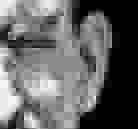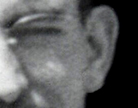Resolution in digital images
Understanding resolution
For
small images, a lower
resolution may seem just fine,
but for bigger images, or for
emphasizing detail, you need
a higher-resolution photograph.
These two images have resolutions
of 100 dots per inch (top)
and 600 dots per inch (bottom).
Here, they are displayed
at about the same
screen resolution.
As you can see, the 100 dpi
image is 1/6 as wide
(and tall) as the 600 dpi image.
Makes sense, doesn't it?
And you can see that they both look OK. In fact, the small image may look better to some people. It's like standing on the street and looking at the front of a house. You may not see the cracked and peeling paint. But if you get close, the imperfections become visible.


Yes, size does matter
But if you make
both images the same size, you'll see
a drastic difference in quality, as
these two details show.


The lesson is this: If you want to have the best image with the greatest flexibility, scan the original at a high resolution. I try to scan all photographs at no less than 600 dpi. For tiny originals or pictures with important detail, I scan at 1200 dpi. And on rare occasions, I use a resolution of 2400 dpi.
Remember that each time you double the resolution, the file size becomes four times larger. Moving from 100 dpi to 600 dpi makes the file size 36 times times bigger. And if you move from 100 dpi to 1200 dpi, you get a file that's 144 times larger. Wow! But these days, storage space on hard drives is cheap, so don't worry about it.
If you have a hi-res image, you can always make a lo-res version for sending by e-mail or for putting on the Web, and you preserve that original version for the future.
copyright James H. Stephens
All rights reserved
